(VOVworld) -The exhibition titled “Twelve Typical Kinds of Vietnamese Folk Paintings”, co organized by the Hanoi Museum and the Hanoi Ceramic Museum, is continuing in Hanoi. Along side it is a thematic seminar with the participation of artisans, specialists, and researchers in the field of traditional fine art nationwide. The event is intended to give audiences a general understanding of the formation and development of folk painting in Vietnam and also suggested ways to protect and revive those traditional genres. VOV's Viet Anh reports
The exhibition displays 12 kinds of folk painting which have almost disappeared or are found only in museums or fine art galleries, even though they are symbols of the culture and aesthetic values of Vietnam because they reflect its social philosophies, and express the thoughts and dreams of its people. According to researchers, Vietnamese traditional folk painting has a history going back thousands of years. They developed through feudal dynasties and proved their place in Vietnamese fine arts. Professor Truong Quoc Binh is former director of the Vietnam Fine Arts Museum and also a member of the country's National Heritage Council. He elaborates on the formation and development of the paintings. “Traditional folk paintings are an indispensable part of Vietnam’s cultural tangible heritage. Those folk paintings were produced using a woodblock printing technique, which existed in Vietnam from 12th century, during the Ly Dynaty. Later, at the end of the Tran Dynasty, paper money printing techniques appeared. At the beginning of the Le So Dynasty, many other techniques of printing boards were adopted, introduced and developed. These folk paintings not only contain aesthetic values, they also represent a history of thousands of years.”
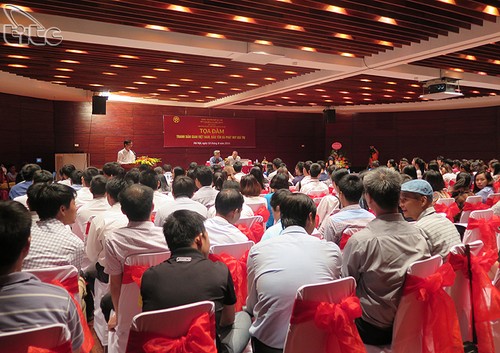 |
| The thematic seminar is intended to give audiences a general understanding of the formation and development of folk painting in Vietnam and also suggested ways to protect and revive those traditional genres (Source: Vietnamtourism.com) |
The production of folk paintings developed widely. Many craft villages formed nationwide specializing in different kinds of paintings. Binh said: “As the printing techniques developed, the production of folk paintings developed in many localities, and so gradually different woodblock carving villages formed nationwide. Those folk paintings were often named after their place of production, for example Dong Ho in Bac Ninh province, Hang Trong- a street in Hanoi, Sinh Village in Hue , and Kim Hoang painting in Ha Tay Province. Even though all the folk paintings in Viet nam apply the same printing techniques, each village has it own unique style making the paintings profoundly impressive.”
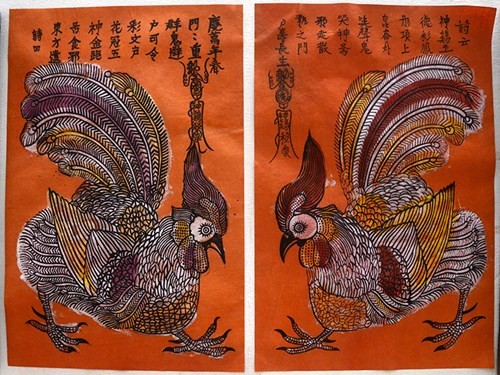 |
| Kim Hoang Folk painting (Source: Tienphong.vn) |
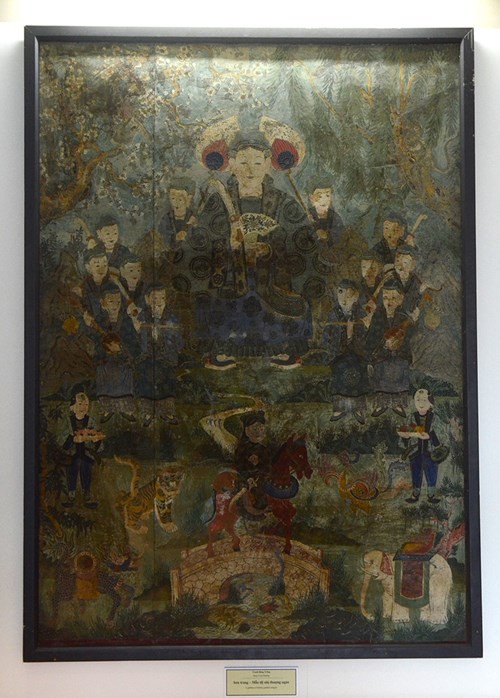 |
| Hang Trong folk painting (Source: Tienphong.vn) |
Themes of the paintings were closely connected with common people and their spiritual lives. Nguyen Tien Da is the Director of the Hanoi Museum. “Traditional Vietnamese folk painting contents can be divided into four categories, including paintings for worshiping, celebrating, illustrating history, and reflecting on people’s daily lives. The paintings contain many layers of aesthetic value, and national quintessence alike. Being filtered through the many ups and downs of the country’s history, those folk paintings found their own position and values which can’t be altered.”
Folk paintings are an important part of Vietnamese people’s spiritual life. Over the years, many painting styles gradually lost their positions. Dating back to the past, those paintings were among the "must-have" items for decorative purposes during the Lunar New Year Festival, or for local worshiping ceremonies. But the tradition has faded over with time, and now, few genres are still preserved and kept going, while others have disappeared or are on the verge of fading from people’s memories. Nguyen Dang Che, an old artisan from Dong Ho folk painting village of Bac Ninh, some 30km North of Hanoi, tells his village’s story. “Before 1945, my village had 17 clans engaged in making Dong Ho folk paintings, which were considered one of the indispensable items for the Lunar New Year Festival. But, the tradition has faded away over time, so most families switched to producing votive paper objects. Nowadays, only two clans in our village still follow the tradition of making Dong Ho paintings, which includes my family and Mr Nguyen Huu Sam’s family. Sadly, Mr Sam died recently at the age of 84, and, I myself have now reached the age of 81, still trying my best do something to preserve the art.”
 |
Nguyen Dang Che, an old artisan from Dong Ho folk painting village of Bac Ninh
(Source: dantri.vn) |
Apart from some famous types of folk painting as Dong Ho and Hang Trong, there are some other less-known ones, including paintings of Sinh Village, Southern Do The, Thap Vat paintings, the royal glass paintings of Hue and the southern region, fabric and scroll fabric paintings, and worship paintings from the mountain regions. Sadly they are all now on the verge of extinction, as demand for them has decreased. Nguyen Thi Thu Hoa, is the Director of the Hanoi Ceramic Museum. “Kim Hoang paintings and plain worship paintings now remain very little known documents as they all face the risk of being lost. The fabric and scroll fabric paintings are now all made by only one artisan, who struggles to find susscessors to take over the work. Or in the case of Hang Trong paintings, there is only one artisan left - Mr. Le Dinh Nghien. Over 60, Nghien is now planning to pass all his skills to his son, in the hope that he will keep Hang Trong painting alive.”
 |
Artisan Le Dinh Nghien of Hang Trong folk painting, Over 60, Nghien is now planning to pass all his skills to his son, in the hope that he will keep Hang Trong painting alive
(Source: Hanoi.gov.vn) |
Recently, more efforts have been poured into the preservation and promotion of folk paintings genres because so many folk paintings can only be found in the museum. Many exhibits, seminars, and festivals have been held inside and outside Vietnam to communicate the value of folk paintings and pass on knowledge of the art to young artists and art lovers. Truong Quoc Binh talked about the significant efforts put into preserving traditional folk paintings and cited some reasons for the discontinuation of the work. “Recently, the old paintings and their woodblocks have been collected and introduced at different museums nationwide. However, it seems like people nowadays doesn’t engage in the habit of buying these paintings. Besides, there remain many difficulties in sourcing the materials and there is less demand, therefore, the craft villages and artisans have to change to other jobs to make a stable living. That’s why the production of paintings has been narrowed down or is even on the edge of disappearing.”
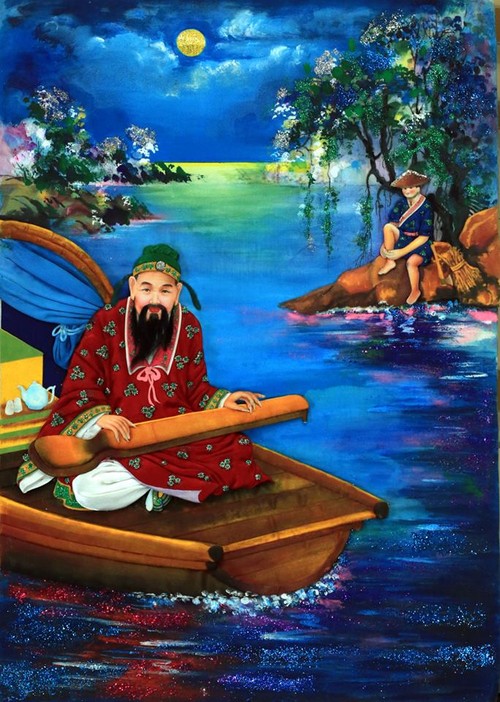 |
| Scroll fabric painting (Source: healthplus.vn) |
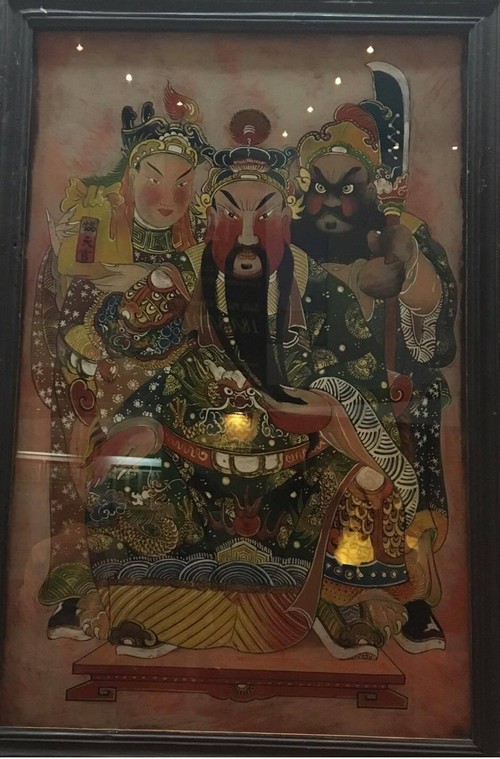 |
| Southern glass painting (Photo: Vietanh/VOV) |
It’s clear that more efforts are needed to preserve and promote folk paintings and revive traditional craft villages. Binh shares his recommendations: "We need a strategic plan for the preservation and development of the folk paintings. We need to provide support, tax incentives for artisans, and build cultural tourism centers, and provide vocational guidance for younger generations, who play a decisive role in long-term protection projects. There should be more coordination among various sectors and agencies in preserving and promoting those traditional folk arts.”
Thanks to non-stop efforts of researchers, some painting genres now are beginning to revive, for example Dong Ho folk paintings. After facing the risk of disappearing, Dong Ho village has now gained in popularity again and become a tourist destination. Artisan Nguyen Dang Che talks about efforts to revive the almost-lost folk genre.“After retiring, I spent time collecting 150 kinds of Dong Ho folk paintings. Later on, I met a French professor, who interested in Vietnamese traditional fine arts. He gave me a colletion of 100 paintings, which can’t be found anywhere else. No one knows exactly how many types of paintings Dong Ho’s villagers have produced. Therefore, I and other researchers are now still searching for more types, while recovering and completing documents for the materials that I have.”
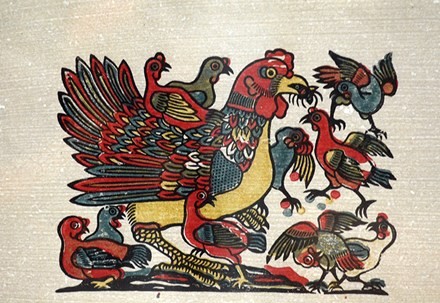 |
| Dong Ho folk painting (Source: Tienphong.vn) |
Dong Ho folk painting has been recognized as a national intangible heritage. The recognition is expected to help preserve and develop the art while increasing the public’s awareness of traditional cultural values. Even though the traditional folk paintings are now not widely used in contemporary life, the spiritual and historical values still remain. Nguyen Tien Da again.“In the modern life, many types of traditional folk art are in decline or are at risk of being lost. However, even if the heyday of folklore paintings has passed, the precious value of each genre hasn’t faded away; they will forever be part of the nation’s cultural heritage.”
This week, we’ve been talking about Vietnamese traditional folk paintings and efforts to preserve them. We welcome your feedback at: English section, VOVworld, Radio Voice of Vietnam, 45 Ba Trieu Street, Hanoi, Vietnam. Or you can email us at: englishsection@vov.org.vn. Tune in to our English program on the Internet at vovworld.vn. Good bye. See you next time.